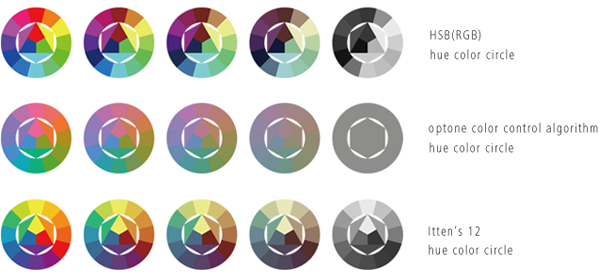

In the optone, the original software controls dynamic color of LED. As computer works on digitized data from input device and the color output should be numerically calculated. Human beings perceive color as stimuli in lightness, hue and chroma. On the other hand, the color stimuli from output device such as computer monitor or full-color LED are light which consist of read, green and blue by additive mixture color method. To control colors visually for human beings by computers, we must be sensitive to this discrepancy and find a new way to manipulate colors by numbers.
Let' s look into the three types of hue color circle (see above). The lowest one is called the Johannes Itten's 12-hue color circle in which yellow, red and blue are selected as primary colors and arranged to maintain the complementary characteristics diagonally. The uppermost one is called the HSB hue color circle in which red, green and blue are the primary colors and extended while maintaining numerical differences of the hue between colors as constant. The middle one is obtained from the Optical Tone Algorithm which maintains the complementary characteristics for diagonal colors and their lightness in a circle as constant. We choose a color model suitable for each design or art work but be aware that on HSB model the hue difference is numerically constant but visually not constant, and the lightness is not also. Johannes Itten's model is visually proportional but numerical continuity is broken, and hard to manipulate by computers. The Optical Tone color model is designed in visually proportional still computational.
Because the optone is aimed to construct a relation between the light-source color and environmental object color by computer, I chose lightness primarily as most important psychological stumuli to control colors, then arranged hue to maintain the complementary characteristics. The obtained algorithm made possible visually comfortable interaction with colors in real space.